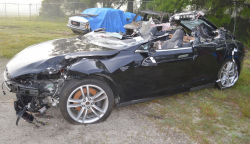
— The National Transportation Safety Board (NTSB) has released hundreds of pages of documents related to the 2016 Tesla Model S crash in Florida that killed former Navy SEAL Joshua Brown.
The documents released by safety regulators cover all aspects of the investigation, including how the Model S and its technology performed, the actions of the driver and how the crash scene was evaluated. In addition, photos included in the documents show damage to the car and the limited damage caused to the trailer attached to the truck.
Brown was driving the Model S on May 7, 2016, west of Williston, Florida, on a clear bright day when the car hit and went under a 53-foot semitrailer attached to a 2014 Freightliner Cascadia truck.
Brown was killed instantly when the top of the Model S was sheered off, leaving the car to continue traveling another 297 feet before the Tesla hit a utility pole. The car broke the pole and traveled an additional 50 feet causing the car to rotate counterclockwise and finally stop in the front yard of a residence.
The Model S Mr. Brown was driving was equipped with automatic emergency braking used to automatically apply the brakes to reduce the severity of a frontal crash or avoid the crash altogether. However, the investigation shows the brakes were never applied, not by the system or by Brown.
As a result of the crash, the battery broke loose from from the electric motors powering the car and the rear hatch frame separated and folded back over the crushed rear window.
Data downloaded from the car showed it was traveling 74 mph at the time of the crash and the Traffic-Aware Cruise Control and the Autosteer lane-keeping systems were activated. The NTSB says it had to rely on Tesla to provide data from the Model S because the automaker has a system not accessible to outside investigators.
Government investigators determined Brown had his hands on the wheel for 25 seconds during the 37 minutes Autopilot was activated, causing the car to provide seven messages that said "Hands Required Not Detected." Six of those warnings included the sound of warning chimes.
Although initial reports indicated Brown may have been watching a movie when the crash occurred, investigators found no evidence his phone or any other devices were being used.
The NTSB says multiple airbags deployed in the Model S but based on recorded data, the airbags didn't deploy when the roof of the car hit the trailer but likely deployed when the car finally hit the utility pole.
A witness described seeing the car pass under the trailer and then a "white cloud, like just a big white explosion," as the Model S came out from under the trailer and started bouncing up and down.
"It was doing that [bouncing], and I started stopping hard and the guy -- I mean, it came out, and I could see, looking right at about an angle like this, he came out, he was over this way, but when that car bounced he kind of came up. And my first instinct was he ducked and he was sitting up, but he flopped right over immediately. I mean, it was real quick..."
The National Highway Traffic Safety Administration (NHTSA) opened an investigation after the Brown crash into Tesla's autonomous technology called "Autopilot" but closed the probe early in 2017 after finding no defects in the systems. NHTSA says Brown relied on the technology too much and should have seen the tractor-trailer at least seven seconds before the crash.
The government also determined Autopilot is comparable to similar technology from other automakers and like the other systems, the technology and automatic emergency braking are designed for rear-end collisions, not a crash such as the one that killed Brown.
The NTSB emphasizes everything in the documents contains only facts collected by investigators and nothing in the material is meant to provide conclusions about how or why the crash occurred. However, all of those findings will eventually be released, including a determination of the probable cause of the crash.




